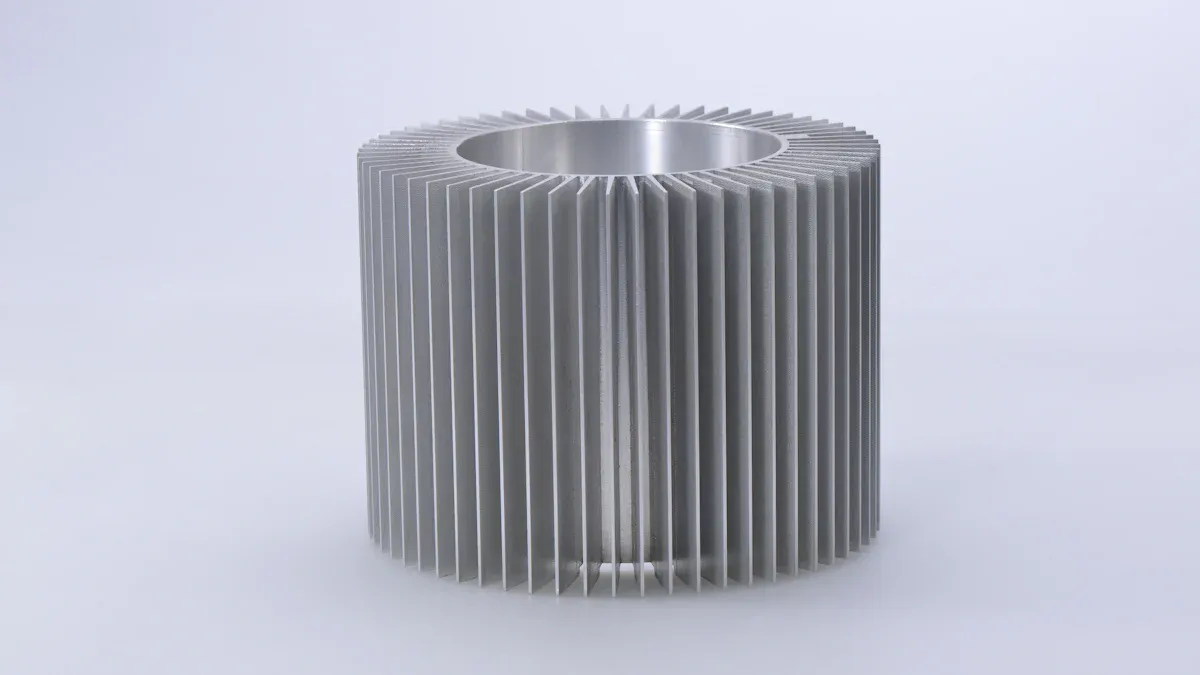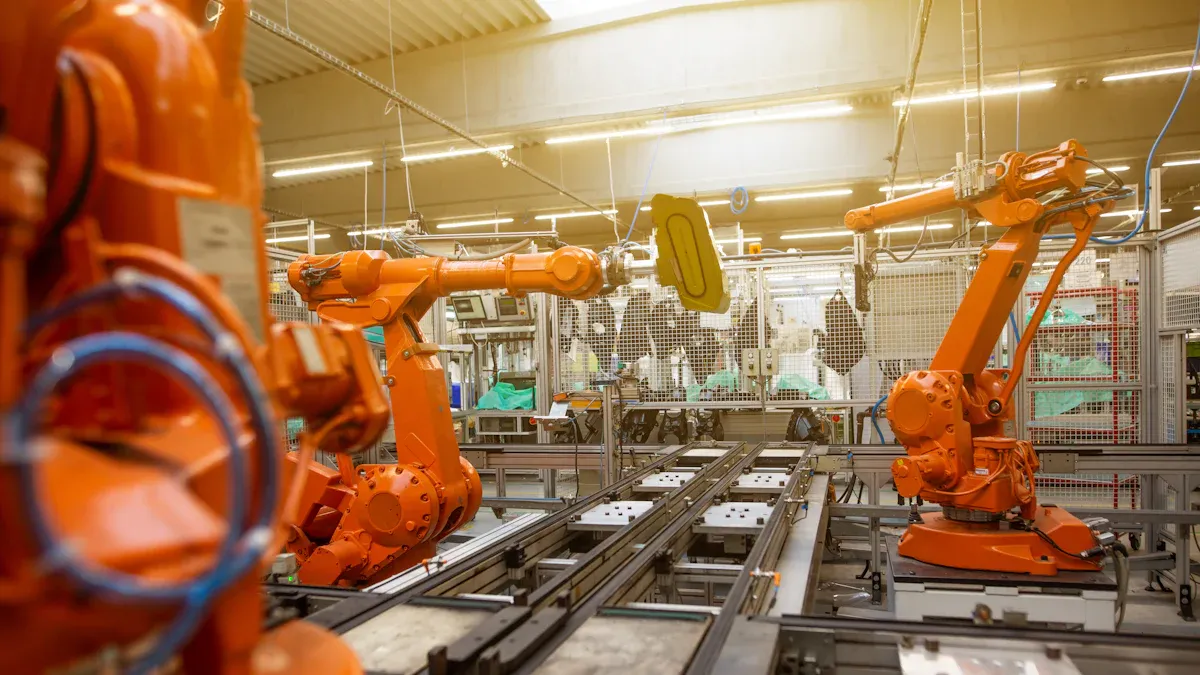Screw barrel design plays a vital role in blow molding, particularly in the context of the bottle blow molding screw barrel. Variations in design, such as those found in the single screw barrel, significantly influence the melting, mixing, and flow rate of materials. A well-constructed bottle blow molding screw barrel promotes uniform temperature distribution, minimizes shear stress, and enhances the quality of molded products. Additionally, understanding the design differences in specific applications, such as the PVC pipe single screw barrel and the PE pipe extruder single screw barrel, leads to improved efficiency and product consistency.
Core Functions of Screw Barrels

Screw barrels serve several essential functions in the blow molding process. Understanding these functions helps manufacturers optimize their operations and improve product quality.
Material Feeding
Material feeding is the first critical function of screw barrels. The design of the screw barrel directly influences how effectively raw materials enter the system. Blow molding screws are specifically engineered for high throughput, differing from injection molding screws that accommodate various materials. This tailored design ensures effective material feeding, which is crucial for maintaining production efficiency.
- Cast feed sections with cooling passages are common in blow molding screws. These features prevent early melting and ensure stable material feeding.
- Integral feed port designs enhance output rates for specific polymers by improving heat migration and friction, thus affecting feeding efficiency.
- The design of the feed section is vital; a shallow groove can lead to insufficient material feeding, causing slippage.
Melting Process
The melting process is another core function of screw barrels. The design of the screw and barrel significantly impacts how well the raw plastic materials melt and mix.
- The melting process begins when high temperatures on the cylinder wall create an initial melt film.
- As melting progresses, the melt accumulates on the active flank of the screw.
- Increased back pressure enhances melting and results in a larger melt pool size.
Optimized screw designs improve melt pressure, which is crucial for wear protection and effective melting of materials. Enhanced designs allow for a wider processing window, accommodating various materials and additives. This flexibility leads to significant cost savings, as evidenced by a reduction in additives from 1.3% to less than 1%, resulting in a 30% cost savings.
Homogenization
Homogenization is the final core function of screw barrels. This process ensures that the melted plastic achieves a uniform consistency before it is shaped into products.
| Aspect | Description |
|---|---|
| Screw Profile Design | Critical for determining final product quality in blow molding. |
| Ingredient Transformation | Governs the breakdown and transformation of ingredients, affecting homogenization and consistency. |
| Shear-Sensitive Materials | High-shear screw profiles can lead to unstable products, highlighting the need for appropriate design. |
| Ideal Screw Profile | Efficiently pumps, breaks agglomerates, homogenizes, and develops appropriate melt temperature and pressure. |
The screw profile design plays a vital role in determining the final product quality. It governs the breakdown and transformation of ingredients, which directly affects homogenization and consistency. An ideal screw profile efficiently pumps and breaks agglomerates while developing the necessary melt temperature and pressure.
Comparison of Design Features
The design features of screw barrels significantly influence the efficiency and quality of the blow molding process. Key aspects such as screw geometry, barrel length and diameter, and flight depth and pitch play crucial roles in determining the performance of the system.
Screw Geometry
Screw geometry refers to the shape and configuration of the screw, which directly impacts energy consumption and output quality. Different screw geometries can lead to varying efficiencies in material processing.
| Screw Geometry Type | Energy Consumption Comparison | Output Quality Comparison |
|---|---|---|
| High-speed, high-efficiency screws | More energy-efficient per output compared to conventional screws | Improved output quality due to optimized design |
| Conventional screws | Higher energy consumption for the same output | Standard output quality |
| Larger diameter screws | Requires larger motors and heaters, increasing energy use | May affect quality due to increased resistance |
The choice of screw geometry can optimize the blow molding process, leading to better energy efficiency and enhanced product quality.
Barrel Length and Diameter
The length and diameter of the barrel also play a significant role in the blow molding process. A longer barrel allows for more time to melt and homogenize the material, which is essential for achieving consistent product quality.
- Longer Barrels: They provide increased residence time for the material, allowing for better melting and mixing. This is particularly beneficial for materials that require more time to reach the desired viscosity.
- Diameter Considerations: A larger diameter can facilitate higher throughput but may require more energy to maintain the necessary temperatures. Conversely, a smaller diameter can improve pressure control but may limit the flow rate.
The balance between barrel length and diameter is crucial for optimizing the blow molding process.
Flight Depth and Pitch
Flight depth and pitch are critical parameters that influence material flow within the screw barrel. The design parameters of flight depth and pitch significantly affect the efficiency of material movement in screw barrel designs.
- A constant depth in certain zones can impact overall material flow, especially in blow molding applications.
- Increasing channel depth can lead to decreased conveying efficiency due to greater particle slippage. This results in a negative impact on the average velocity of the solid bed, which is crucial for understanding material flow in blow molding.
- Reducing flight widths to compensate for increased channel depth has minimal effect on material flow efficiency. The change in screw surface area has a more significant impact on material flow than the volume change from adding a second flight.
The optimal flight depth is influenced by the solid properties of the polymer, including bulk density and frictional characteristics. Melt viscosity also affects the required feed depth; lower melt viscosity necessitates a greater feed depth to enhance the melting rate. Determining the ideal flight pitch relies heavily on experience and testing due to the complex interactions of polymer solid parameters.
Understanding these design features allows manufacturers to select the appropriate screw barrel configurations for their specific blow molding applications, ultimately leading to improved efficiency and product quality.
Implications on Product Quality
Screw barrel design significantly impacts the quality of blow molded products. Key factors include surface finish, dimensional accuracy, and cycle time efficiency.
Surface Finish
The surface finish of blow molded products relies heavily on the screw barrel design. Several aspects contribute to this quality:
- Screw barrel design affects melt quality, temperature distribution, and material consistency, which are crucial for surface finish.
- Customization of screw geometry, compression ratios, and mixing sections leads to improved melt quality and uniformity.
- Each functional zone of the screw, including feed, compression, and metering, must be calibrated for the specific polymer to ensure optimal processing conditions.
Dimensional Accuracy
Dimensional accuracy is vital for ensuring that molded products meet specifications. Various design parameters influence this aspect:
| Design Parameter | Influence on Dimensional Accuracy |
|---|---|
| Material Properties | Different polymers have distinct melting points and flow characteristics, affecting uniformity and strength. |
| Mold Design and Size | Larger molds require longer cooling times; insufficient cooling can lead to warping and uneven walls. |
| Product Thickness and Wall Uniformity | Adjusting parison thickness is crucial; uneven thickness can create weak spots in the final product. |
| Production Speed and Efficiency | Higher speeds can reduce cooling time, risking deformities and dimensional inaccuracies. |
| Environmental Conditions | Ambient temperature and humidity can affect material properties, leading to defects like bubbles or voids. |
Cycle Time Efficiency
Cycle time efficiency is essential for maximizing production output. The design of screw barrels plays a crucial role in this area:
- The design of screw barrels affects melt temperature, which is crucial for cycle time efficiency.
- Advanced screw designs enable better control over energy consumption and material mixing.
- Lower melt temperatures can lead to reduced energy consumption and shorter cycle times.
By optimizing these factors, manufacturers can enhance the overall quality of their blow molded products.
Bottle Blow Molding Screw Barrel Characteristics

L/D Ratio
The L/D ratio, which stands for the length-to-diameter ratio of the screw, significantly influences the performance of bottle blow molding screw barrels. A higher L/D ratio allows for longer residence time of the material within the barrel. This extended time enhances mixing, melting, and chemical reactions, which are essential for achieving uniform melt homogeneity. Uniformity is vital for producing high-quality bottles. Single screw barrels designed for blow molding often feature grooved feed screws and deep flights to improve resin melting and mixing. Additionally, a barrier mixing section near the screw end ensures effective polymer blending, directly impacting the quality of the final blow-molded bottles.
Barrier Design
Barrier design in screw barrels plays a crucial role in polymer processing efficiency. It helps maintain melt stability and prevents defects during production. The inclusion of a barrier section minimizes the risk of material degradation and ensures consistent melt quality. This design feature is particularly important when processing materials that may be sensitive to thermal stress. Proper temperature control and machine settings can optimize the barrier design, reducing the likelihood of warping or cracking, which can lead to inconsistent melt and defects.
| Cause | Impact on Defects and Waste | Preventive Measures |
|---|---|---|
| Abrasion from additives | Excessive wear leading to contamination | Use compatible, non-abrasive materials |
| Thermal stress | Warping or cracking causing inconsistent melt | Optimize temperature control and machine settings |
| Operational errors | Residue buildup and uneven processing causing defects | Train operators on proper usage and cleaning |
Screw Clearance
Screw clearance is another critical specification in bottle blow molding. Proper clearance ensures efficient melting, mixing, and conveying of materials, which helps minimize defects in the final product. The recommended clearance for most extrusion processes is between 0.001 to 0.002 times the screw diameter. For injection molding machines, the clearance is typically tighter, ranging from 0.001 to 0.003 times the screw diameter. Maintaining the right clearance is essential for achieving optimal performance in the blow molding process.
In summary, screw barrel designs vary significantly, impacting material compatibility, production efficiency, and product quality. Selecting the correct design can enhance output by up to 25% and reduce cycle times. Experts stress that understanding material flow behaviors is essential for achieving smooth processing. Proper design choices lead to optimal results in blow molding.
FAQ
What is the role of screw barrel design in blow molding?
Screw barrel design optimizes material melting, mixing, and flow, directly impacting product quality and production efficiency.
How does the L/D ratio affect blow molding?
A higher L/D ratio enhances residence time, improving mixing and melt uniformity, crucial for high-quality blow-molded products.
Why is barrier design important in screw barrels?
Barrier design maintains melt stability, prevents degradation, and ensures consistent quality, especially for sensitive materials during processing.
Post time: Sep-25-2025
